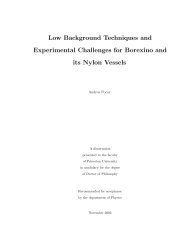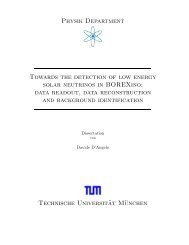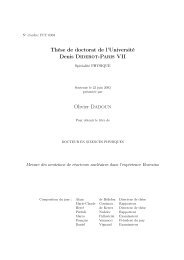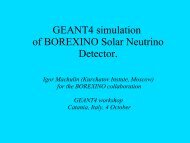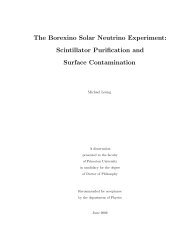Development of a Liquid Scintillator and of Data ... - Borexino - Infn
Development of a Liquid Scintillator and of Data ... - Borexino - Infn
Development of a Liquid Scintillator and of Data ... - Borexino - Infn
You also want an ePaper? Increase the reach of your titles
YUMPU automatically turns print PDFs into web optimized ePapers that Google loves.
5 Particle Identification with a Neural Network<br />
5.2 Artificial Neural Networks<br />
The term artificial neural network (NN) describes where they come from: the task to replicate<br />
the main feature <strong>of</strong> the human brain, i.e. the network <strong>of</strong> neurons. The hope was that a combination<br />
<strong>of</strong> the complex design <strong>of</strong> the brain <strong>and</strong> the technology <strong>of</strong> modern micro processors<br />
could combine the advantages <strong>of</strong> both: good pattern recognition capabilities <strong>and</strong> fast signal<br />
transmission.<br />
An artificial neural network can be thought <strong>of</strong> as a sort <strong>of</strong> ‘black box’ processing system; its<br />
operational capabilities allow the reproduction <strong>of</strong> an application between two sets <strong>of</strong><br />
vectors. In a neural network the basic units are called neurons. A neuron has several input <strong>and</strong><br />
output connections, <strong>and</strong> the weighted sum <strong>of</strong> all the signals received by a neuron generates its<br />
activation<br />
Ø<br />
<br />
<br />
ÛÜ <br />
Ü are the input values, Û are the weights <strong>and</strong> is a threshold potential (see 5.4). The activation<br />
function is very <strong>of</strong>ten chosen as a sigmoidal function such as<br />
Ü <br />
The constant Ì sets the gain <strong>of</strong> the activation function. The output Ó, the signal which is sent<br />
to the neighbouring cells, is calculated from the activation by an output function<br />
<br />
Ó ÓÙØ <br />
ÜÌ <br />
In the simplest case, the output function is the identity function, so that<br />
Ó ÓÙØ <br />
With this simple neuron, various types <strong>of</strong> networks <strong>and</strong> architectures can be built. One <strong>of</strong> the<br />
most widely used is the feed-forward, multilayer neural network with supervised training. In<br />
66<br />
x 2<br />
x 1<br />
w 2<br />
<br />
w 1<br />
Figure 5.4: A simple neural network consisting<br />
<strong>of</strong> two input neurons, Ü <strong>and</strong> Ü ,<br />
with specific weights Û <strong>and</strong> Û , <strong>and</strong> one<br />
output neuron Ý with a threshold .<br />
y<br />
<br />
<br />
Figure 5.5: Schematic <strong>of</strong> a three layer feedforward<br />
neural network.



